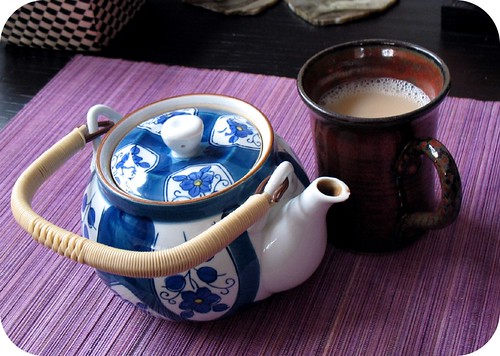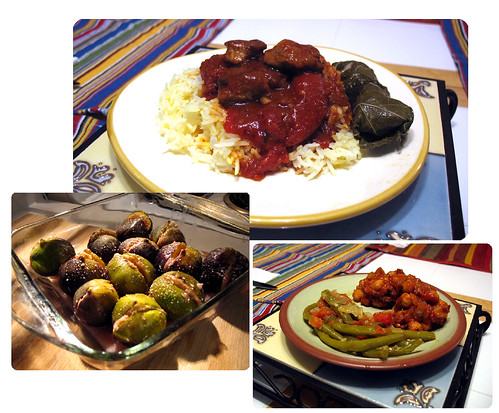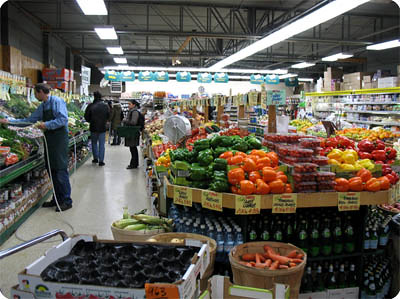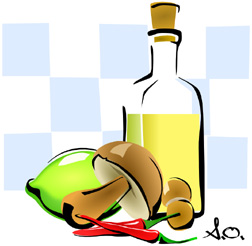 Flavoured mustards from Made in France, a specialty store in Ottawa, originally uploaded by beFOODled.
Flavoured mustards from Made in France, a specialty store in Ottawa, originally uploaded by beFOODled.
Check out my most recent guest post for Food Network Canada about Made in France, a specialty store in Ottawa that sells the most amazing flavoured mustards. My other favourite reason for going here is because it reminds me of my recent trip to France for a culinary vacation.
Wednesday, December 31, 2008
Made in France, sold in Ottawa
Posted by
Asha at beFOODled
at
9:00 AM
0
comments
![]()
Labels: bazaar, beFOODled, food blog, Food Network Canada, French food, Made in France, Ottawa grocery stores




Monday, December 29, 2008
Ichibei, a Japanese restaurant in Ottawa
 Ichibei, a Japanese restaurant in Ottawa, originally uploaded by beFOODled.
Ichibei, a Japanese restaurant in Ottawa, originally uploaded by beFOODled.
I recently wrote about my favourite Japanese restaurant in Ottawa for Foodtv.ca. I also reviewed it earlier this year on beFOODled. I bet you're curious about the identity of that cute little animal in all of the pictures, the one with a bellyful of sake! Either post will tell you about him, so click on to find out more.
Posted by
Asha at beFOODled
at
7:32 PM
0
comments
![]()
Labels: bazaar, beFOODled, food blog, Food Network Canada, foodtv.ca, Ichibei, Japanese food, Ottawa restaurants




Sunday, December 28, 2008
George Orwell and beFOODled on the perfect cup of tea
 George Orwell and beFOODled on the perfect cup of tea, originally uploaded by beFOODled.
George Orwell and beFOODled on the perfect cup of tea, originally uploaded by beFOODled.
Author George Orwell, who voluntarily lived like a tramp in the late 1920s to research material for his book Down and Out in Paris and London, paradoxically had no fewer than 11 outstanding rules on how to make a nice cup of tea.
I wish I could tell George that, aside from loving his afore-mentioned book, I have unknowingly been following most of his advice when making tea, maybe because I come from a family of tea aficionados. But I differ from him on some key points, for example, in belonging to the milk-first school. And some of Orwell's points simply do not apply in today's society, such as making tea in urns and cauldrons versus teapots, which perhaps happens in the army, but I can't think of where else.
So here's beFOODled's list of no less than eight outstanding points on how to make the perfect cup of tea.
* First of all, dump out any old water in the kettle and only boil fresh water.
* Make tea in a teapot rather than in a cup for maximum steepage.
* Loose tea in big flakes that can swirl freely around the pot or in a wire mesh are preferable to tea bags. (George was anti-wire-mesh holders, so he might raise an argument against this one.)
* Blend your favourite teas for a unique taste. My favourite recipe is 1.5 to two teaspoons of a strong black Indian tea, such as Assam, Ceylon or Darjeeling, usually found in blends for English Breakfast or Irish Breakfast teas. I then add a pinch of smoky Lapsang Souchong, a black tea from China dried over burning pine, for flavour, and a couple of crushed cardamom pods and seeds. Do not make tea using only Lapsang Souchong (S did this once and it was a bit of an issue). It's so strong and smoky that most people find it undrinkable as a main brew.
* Bring the teapot to the kettle, not the kettle to the teapot. (On this point, George and I agree.)
* Let the tea steep in the teapot for about five minutes before pouring out.
* Nuke a bit of milk in the bottom of tea mugs in the microwave for about 20 seconds. (George, who belongs to the tea-first school, would have been at odds with this point.)
* Pour tea in your cups and enjoy!
Posted by
Asha at beFOODled
at
10:57 AM
1 comments
![]()
Labels: beFOODled, food blog, history bites, how to, tea




Wednesday, December 24, 2008
Choice Cuts book review
 Choice Cuts book review, originally uploaded by beFOODled.
Choice Cuts book review, originally uploaded by beFOODled.
Do any of you have a favourite book on food writing out there? My friend Deirdre of The Film Cricket gave me Choice Cuts last Christmas. The title is an apt description because it's a compendium of food musings cut from the works of literary giants and food writers throughout the ages (all of whom are introduced in the foreward by Mark Kurlansky).
I particularly like the entries by George Orwell from Down and Out in Paris in London, where he describes the behaviour of Paris cooks and waiters. There are excerpts from historians Herodotus and Plutarch on Egyptian and Roman attitudes to food, and choice cuts from more modern but still pioneering food writers, such as French lawyer Jean Anthelme Brillat-Savarin and the American M. F. K. Fisher.
The chapters are arranged according to a creative theme, such as "Food and sex," "Poultry, fowl and other ill-fated birds," "The mystery of eggs" and "The dark side of chocolate."
Some excerpts are a few words, others a few pages. There are poems, quotes, literary passages and photographs with captions. It's truly a great gift idea for the busy foodie!
Posted by
Asha at beFOODled
at
12:10 AM
0
comments
![]()
Labels: beFOODled, book review, Choice Cuts, food blog, food writing, George Orwell




Friday, December 19, 2008
Lamb braise with saffron rice
 Lamb braise with saffron rice, originally uploaded by beFOODled.
Lamb braise with saffron rice, originally uploaded by beFOODled.
You may have noticed there are a lot of stew-type recipes on beFOODled. I think that's because braising is my favourite way to cook. I just really like the flavours and textures of tomato-based one-pot dishes. Plus, braises are slow food, and I often like to cook for a bit, toddle off to do something, such as blog, then return to eat. Yes, that's it. It's a method that is forgiving of distractions.
Lamb braise with saffron rice
1 kg lamb shoulder, cut into bite-size cubes
a handful of all-purpose flour
grapeseed (or canola) oil
a handful of pearl or cipollini onions, peeled
1 - 2 garlic cloves
2 celery ribs, finely chopped
2 carrots, finely chopped
100 mL of cider vinegar
1 tsp sugar
a glug of your favourite BBQ sauce
28-oz can of plum tomatoes (I like San Marzano brand)
1/2 - 1 cup of chicken stock
fresh thyme sprigs
2 bay leaves
ground coriander
chopped parsley
Put the flour in a large plastic bag and toss the lamb cubes until lightly coated. Brown the lamb in batches in an oiled frying pan but do not cook all the way through. Set aside.
Add some more oil and fry the carrots, celery and onions for a few minutes. Add the garlic and. Turn up the heat and add the vinegar and sugar and deglaze the bottom of the pan. Lower the heat and add the tomatoes, the BBQ sauce, chicken stock and herbs and spices. Stir and cover and cook on very low heat (about 2 or 1) for 1 to 1.5 hours. Add a bit more stock if it needs more liquid while braising. Serve with chopped parsley sprinkled over.
To make the saffron rice, make basmati rice in your rice cooker as usual, but cook it using some water that's had a pinch of saffron soaking in it for about 30 minutes. It will come out a pretty yellow and taste fantastic.
Wednesday, December 17, 2008
The Gastronati's Lebanese and Syrian night
 The Gastronati's Lebanese and Syrian food night, originally uploaded by beFOODled.
The Gastronati's Lebanese and Syrian food night, originally uploaded by beFOODled.
After a long time off because of other commitments, the Gastronati, my group of foodie friends, reunited with a Lebanese and Syrian feast. S and I made a sweet and sour lamb stew with saffron rice. PB and J brought sweet, honeyed figs and dolmades. And Calimocho and Squeaky brought a green bean dish and a Lebanese moussaka. Lebanese moussake is made from eggplant and chickpeas and is more like a stew than the Greek version, which resembles a lasagna.
Posted by
Asha at beFOODled
at
6:13 PM
0
comments
![]()
Labels: beFOODled, food blog, Gastronati, Lebanese food, Syrian food




Tuesday, December 9, 2008
Herb and Spice — a friendly specialty store in Ottawa
All kinds of fresh foods have a home at Herb and Spice, a specialty grocery store in my old stamping ground of Wellington West in Ottawa. The produce here both looks good and tastes great, but I have found yet another reason to like the place. You can find out more in my guest post on Food Network's Bazaar :)
Posted by
Asha at beFOODled
at
6:13 PM
0
comments
![]()
Labels: bazaar, beFOODled, food blog, Food Network Canada, foodtv.ca, Ottawa grocery stores




Friday, December 5, 2008
Cheese, mushroom and caramelized onion omelette
Here's the recipe for S's special breakfast omelette. It is delicious and a little bit sweet because he uses sugar to caramelize the onions.
Cheese, mushroom and caramelized onion omelette
half of a large onion, sliced
six mushrooms, sliced
dry herbs or fresh chopped herbs
green onions (optional)
balsamic vinegar
sugar
Worcestershire sauce
knob of butter
olive oil (or another oil)
2 eggs
mozzarella cheese
salt and pepper
Fry the sliced onion and mushrooms together in the oil. Season with salt and pepper after they have sweated for a bit (released some of their water). Add some fresh chopped herbs, such as rosemary or thyme, or some dried, and some sliced green onions, if you wish. Once the vegetables start browning, glug in about half a tablespoon of balsamic vinegar, the same amount of sugar and a dash of Worcestershire sauce. Let that reduce for a bit until everything looks like it has been absorbed. Set the mixture aside.
Crack two eggs in a measuring cup and beat together. In a separate frying pan, add a knob of butter, enough to spread around the pan. When the pan is at medium heat, add the eggs and swirl them around so they spread out evenly. Wait until the eggs have solidified a little bit. Add the mushroom mixture to one half of the omelette. Slice some mozzarella cheese and then rip it into chunks, and spread it over the top of the mushrooms.
Using a fork, peek underneath the omelette. Wait until the underside is just starting to brown and then take the pan off the heat and hold it over a plate. Slide the omelette off so that the side with the mushrooms lands on the plate first. Then lift the pan up and over so the other half of the omelette flops over on top on the mushrooms. Serve immediately.
Posted by
Asha at beFOODled
at
5:22 PM
0
comments
![]()
Labels: beFOODled, breakfasts, food blog, French food, omelette










